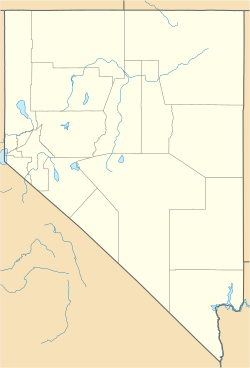Gypsum Cave (Nevada) facts for kids
Quick facts for kids |
|
|
Gypsum Cave
|
|
| NRHP reference No. | 10000443 |
|---|---|
| Added to NRHP | July 8, 2010 |
Gypsum Cave is a cool limestone cave located about 15 miles east of Las Vegas in Nevada, USA. It's a pretty big cave, with six different rooms. It measures about 320 feet long and 120 feet wide.
This cave was first written about by Mark Raymond Harrington in 1930. For a very long time, up until about 11,000 BC, Gypsum Cave was home to an ancient animal called the Shasta ground sloth.
Not far from the cave, there's also the Gypsum Cave Mine. This mine contains minerals like gypsum, anhydrite, and even uranium.
Contents
Discovering Gypsum Cave's Past
People have lived in Gypsum Cave for a very long time. We know this because human tools and other signs of life have been found there. The earliest signs show people lived here around 3000 BC.
In 1930 and 1931, archaeologist Mark Raymond Harrington led a team to dig and explore the cave. This was the first time anyone really documented what was inside. People also lived at other nearby places like Tule Springs and Lake Mojave around the same time.
The Ancient Ground Sloth
One of the most exciting finds in Gypsum Cave was the skull of a ground sloth. This sloth was a type called Nothrotheriops shastensis. It was found in one of the cave's rooms by Bertha Parker Pallan. She was an archaeologist and also Harrington's niece.
The team found more than just the skull. They also found sloth dung (poop!), bones, claws, and even reddish-brown hair. These amazing discoveries are now kept at the Natural History Museum of Los Angeles County.
Scientists used a method called radiocarbon dating to find out how old the sloth remains were. They learned that the sloth lived around 11,000 BC or even earlier.
What Sloth Poop Tells Us
The ancient sloth dung was very important! Since the sloth was a plant-eater (a herbivore), its dung showed what plants it ate. This helped scientists learn about the environment and plants that grew in the area long ago.
The sloth ate plants like capers, mustards, grasses, agave, yucca, and grapes. Many of these plants still grow in the area today. However, during the Ice Age, the climate was cooler and wetter. This meant some plants, like agave and yucca, grew at lower elevations back then.
A Horse from the Ice Age
In 2017, scientists made another cool discovery about a skull found by Harrington in the 1930s. They realized it wasn't a ground sloth skull after all! It belonged to an extinct type of horse. This horse had long, thin legs and died out during the last Ice Age, around 13,000 BC.
This ancient horse was not closely related to modern horses. It was given a new scientific name: Haringtonhippus francisci. It was named after a Canadian scientist named Charles Richard Harington.
Protecting the Cave Site
In 1994, a special sign was put up to help tourists find Gypsum Cave. This sign was Nevada State Historical Marker #103. However, the private company that owned the land, PABCO Mining Company, later removed the sign. They wanted to prevent too many visitors on their property.
Later, in the early 2000s, the Bureau of Land Management looked into building a power line nearby. Native American tribes in the area identified Gypsum Cave as one of only two sites that were very important to their culture. This shows how special and historically significant Gypsum Cave is.



